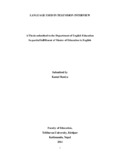Please use this identifier to cite or link to this item:
https://elibrary.tucl.edu.np/handle/123456789/1900| Title: | Language Used in Television Interview |
| Authors: | Baniya, Kamal |
| Keywords: | Language;Television |
| Issue Date: | 2014 |
| Publisher: | Faculty of Education |
| Abstract: | The Present research study entitledLanguage used in Television Interviewisan attempt to find out the politeness principles used in television interview. Thestudy sought to find out whether the language used in television interview wasdifferent from language used in other fields. The main objective of myresearch was to find out the politeness principles.The samples of interviewswere collected from the original sources like Kantipur television, Nepaltelevision, BBC. In this research, the numbers of interviews were twenty. Thisresearch adoptedSurvey research design and data wereanalyzedandinterpreted on the basis of observation tools considering different politenessmaxims, which are indispensable in order to make the interview praiseworthy.So the main findings of this research show that Tact Maxim, GenerosityMaxim, Approbation Maxim, and Agreement Maxim were found to bemaximally used. In this research I have analyzed and interpreted the interviewson the basis of politeness principles that may provide information/ideas,reference to other researchersor peoplewho are involvedin the mass media. This research consists of five chapters. The first chapter deals withbackground/context, this chapter also incorporates statement of the problems,rational, objectives of research, Research questions/ hypothesis, significance,delimitationof the study, and operational definition of the key terms. Chaptertwo deals with review of theoretical and empirical literature .The review oftheoretical literature consists of general information about Mass media,significant of Mass media, types ofMass media, introduction of journalism,principles of modern journalism, electronic media, interview, principles used intelevision interview, politeness principles used in television interview , facesaving act, and face threatening act. It also consists of theory related to massmedia like Lass Well's model, interaction model and conceptual framework.Chapter three dealswith methods and procedures of the study which consist ofdesign of the study, population sample, data collection, data analysis ix procedures. Chapter four is the main part of study which greatly deals withanalysis and interpretation of collected data. The last chapter covers theinformation about summary, conclusion and implication which are based onanalysis and interpretation of collected data. At the end references andappendices have been included. |
| URI: | http://elibrary.tucl.edu.np/handle/123456789/1900 |
| Appears in Collections: | English Language Education |
Files in This Item:
| File | Description | Size | Format | |
|---|---|---|---|---|
| cover.pdf | 32.25 kB | Adobe PDF |  View/Open | |
| chapter.pdf | 253.42 kB | Adobe PDF |  View/Open |
Items in DSpace are protected by copyright, with all rights reserved, unless otherwise indicated.
